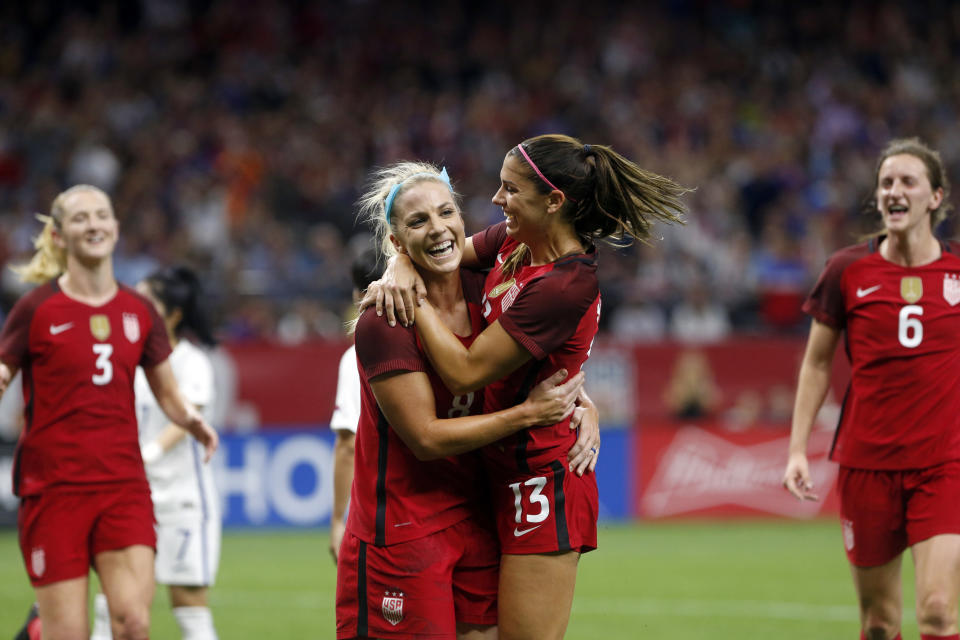USWNT wins against South Korea, but loses on turf... again

So what was the point of all this?
Why put the United States women’s national team — not merely the only World Cup champion the country has, but now also the only team that can still qualify for its next edition — through another grueling game on artificial turf? When there is absolutely no reasonable justification to do so?
On Thursday, the defending Women’s World Cup winners beat South Korea 3-1 in an entertaining friendly match in the 73,000-seat Superdome in New Orleans. But the game drew just 9,371 fans. Large swaths of even the stadium’s lower bowl were completely empty. And all this brings up the pertinent points of an old dispute.
The New York Times recently reported that the women’s national team and the federation still have fundamental disagreements about playing surface.
You’ll recall that in the USWNT’s recent and very public fight with the federation over the terms of a new collective bargaining agreement, most of the animus surrounded the players’ pursuit of equal pay with the senior men’s team — in spite of completely different pay structures. At length, the women didn’t get a guaranteed equal payment but did secure big raises. As it happens, pegging income to that of the men might not have been wise anyway, since they summarily failed to win for the 2018 World Cup.
But a secondary struggle was the one for women’s games to be played only on grass, just as the men are almost never asked to punish their ankles and knees with significantly more wear and tear on an engineered surface. Late last year, the women refused to play in a game in Hawaii because the surface was simply too poor to even contemplate playing on it — after Megan Rapinoe tore a ligament in practice. And before the 2015 Women’s World Cup, a group of players sued to move the games to grass, and lost.
Yet after this issue was addressed in the new CBA — the women’s players would be consulted over stadium choices and every effort would be made to avoid artificial turf — the federation happily went on booking women’s games on plastic grass. In mid-September, the Americans played on artificial turf in Cincinnati. And on Thursday, they did so again in New Orleans.
The quality of the field in New Orleans is such that the women had specifically requested it not be selected for a game, per the Times, yet there they were on Thursday, drafted into action on a field not worthy of the women’s game’s dominant program. U.S. Soccer reportedly discarded several suggestions from the women’s Players Union for alternative venues in New Orleans.
But U.S. Soccer has said several factors prevent such moves. One of them is the need to scatter the slate of women’s games all over the country in order to help it grow. (This happens to a lesser extent on the men’s side, which somehow doesn’t need to sell itself to the country, in spite of lower attendance figures as compared to the women.) Another is the unavailability of certain preferred stadiums. (Again, this doesn’t seem to be an issue when it comes to keeping the men’s team on real grass.)
And if the overarching objective is to rotate through the various markets, what good does it do to go to a place where attendance didn’t even crack five figures? That undermines the entire argument. The cavernous Superdome was plainly the wrong stadium for this game. For a whole host of reasons.
Still, the USA ran roughshod over Korea in the first half, blending a direct style with a more sophisticated one that found seams in the tightly packed Korean lines. The Koreans were playing on the transition, quickly bursting forward, but without forging many clear-cut chances.
Some 24 minutes in, Julie Ertz gave the U.S. the lead on a magnificent diving header from Rapinoe’s corner.
Julie Ertz at the near post? Always a good idea.
That's 4 goals in her last 5 games for the #USWNT! https://t.co/wvgiT57Xjr
— FOX Soccer (@FOXSoccer) October 20, 2017
And before halftime, a lovely combination between Mallory Pugh and Kelley O’Hara on the right side freed the latter up by the end line. O’Hara cut back for Alex Morgan, who took a deft touch, turned and scored artfully.
The turn. The finish. Career international goal No. 78 for Alex Morgan! #USWNT https://t.co/lLK2Il2bSF
— FOX Soccer (@FOXSoccer) October 20, 2017
Deep in first-half injury time, Korea got back in the game with a splendid long shot by Han Chaerin that beat Alyssa Naeher, who couldn’t do much about it.
Okay! We see you, Han Chaerin!
Not a bad way to start your international career… #USAvKOR https://t.co/lQSPZIeNvR
— FOX Soccer (@FOXSoccer) October 20, 2017
But after the intermission, Rapinoe was chopped down in the box and converted her own penalty kick. Chaerin pinged another long shot off the upright, but Korea was already beaten.
Slowly, this drastically rejuvenated women’s team is coming together as it crawls toward next year’s Women’s World Cup qualifiers, finally ending two years without a competitive game then. To those who only check into this team for World Cups and Olympics, the faces will mostly be different.
But one thing remains the same. The women’s national team is still fighting for equality. And there is still no convincing reason for why it’s made to deal with inferior surfaces. Especially when few people even show up.
Leander Schaerlaeckens is a Yahoo Sports soccer columnist and a sports communication lecturer at Marist College. Follow him on Twitter @LeanderAlphabet.



